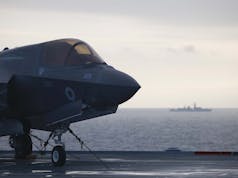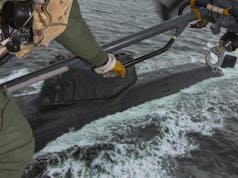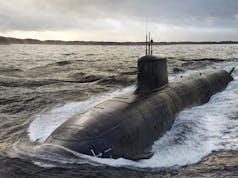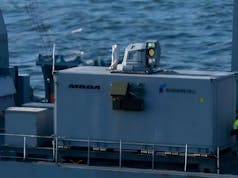As one goes out, another comes in.
A Royal Navy Vanguard-class submarine has returned home to the Clyde after an extended deployment, marking the end of another lengthy patrol in the depths of the ocean.
The submarine, bearing the unmistakable signs of a prolonged time at sea, is believed to have been on patrol for nearly six months, underscoring the increasing demands placed on these vessels in recent years.
— Sheila Weir (@SheilaLWeir) August 31, 2024
This latest homecoming is a poignant reminder of the extraordinary endurance required by the crew, following closely on the heels of a similar deployment in September 2023. During that earlier patrol, another Vanguard-class submarine made its way back after what was reported to be an unprecedented 190-day time at sea, setting a new benchmark for extended deployments within the fleet.
The growing duration of these patrols is largely attributed to issues around maintenance, covered extensively here and elsewhere. The original plan to construct a fleet of four nuclear-armed submarines was carefully calculated to ensure continuous operation.
The strategy was that, at any given time, one submarine would be in dry dock at Devonport for deep maintenance, while patrol duties would rotate among the remaining three. This rotation was expected to provide enough flexibility for short-term repairs and training.
However, as the fleet ages and operational challenges mount, the length of these missions has steadily increased.
Sacrifice and Dedication
The commitment and sacrifice demonstrated by the crews of these submarines cannot be overstated. Spending months at a time submerged, often in challenging conditions, requires not only physical resilience but also remarkable mental fortitude.
These sailors endure prolonged separation from their families and loved ones, dealing with the psychological pressures that come with such isolation.
Their efforts play a crucial role in maintaining Britain’s security, ensuring that the UK’s nuclear deterrent remains both credible and operational. The relentless dedication of these submariners, who perform their duties largely out of the public eye, is a testament to their professionalism and unwavering commitment to their country.
These men and women have once again demonstrated the extraordinary capabilities and resolve of the Royal Navy, continuing a tradition of excellence that dates back centuries.














good
Surely the original plan was for 5 boats (in the Polaris era). Cut to 4 by the Treasury.
Yep, originally 5 were planned but number 5 was cancelled which in some ways benefited the remaining 4,as long lead items maintained them for many years .
Is Silent Service pay greater than that for other areas?
It should be with that sort of crazy isolation.
Yes, there is such a thing as Submarine Pay. It probably isn’t enough!
They do mate. Its quite a bit more. And i believe they get a bonus on completion of training. And maybe also a signing up bonus if you volunteer from the general service. I remember during week 2 or 3 on my phase 1 training at HMS Raleigh, we had a silent service presentation to try and temp people over. They made a big thing of the extra pay. Life on a boat is also more relaxed in many ways compared to a skimmer.
Presume you successfully resisted the temptation? 😁
Given increased maintenance issues w/ Vanguard class, possible to adopt a different deployment model until sufficient Dreadnought class boats commissioned? Limit deployments to four months to preserve longer-term crew morale. If another V boat is unavailable for immediate replacment CASD duty, negotiate w/ MN and/or USN to provide additional short term replacement coverage. 🤔 Gapping capability/coverage has become SOP. Could lend credibility to a stated requirement for an increased MoD budget during the next Strategic Review (perhaps ,🤞).
I did resist, mate. It was Fleet Air Arm all the way for me. Could you imagine the comments if CASD was gapped/covered by the US Navy. It also wouldn’t be a UK independent capability if it wasn’t an RN boat on patrol, which throws up a whole world of problems.
fe
Hi George,
I’d like to second your comments regarding the dedication of the crews. Well said, sir.
I’d also like to add that the politicians who have inflicted foolish austerity cuts on the maintenance support for the SSBN and SSN force should hang their heads in shame.
This and the state of the RFA and retention within the services generally demonstrates that politicians have failed in their self proclaimed first duty to ensure our nation’s security.
Finally, I’d like to say a big thank you to all our service personnel who put themselves forward to keep the rest of us safe in these changing times.
Thank you,
CR
I agree. The Trident weapons system is used every day of the year. It takes a lot of effort.
The question has to be asked is four boats enough. In a perfect world it is but they are increasingly complex boats and the odds of one needing extensive time in refit due to unforeseen circumstances is now almost a certainty and the knock on effect it has to the other boats.
Which inevitably means increasing risk of mechanical breakdown or a serious crew error endangering the boat .
The defence budget NEEDS, Must go higher or at least one off funding needs to be found.
yes
When are these boats going to be replaced?
The first of the next class, HMS Dreadnought, is expected in service in the early 2030s.
The first of the next class, HMS Dreadnought, is expected in service in the early 2030s.
Hi folks hope all is well.
Good for them and the safe return to home after keeping us safe sound and secure. Not much in main stream media though for the magnificent work of the sub service does for us. Of courseif there was a failed missile test that would be all over the news!
Nonetheless, we do need at least another one or two Dreadnoughts after the lessons of the hard work of the current fleet.
Cheers
George
g
The original plan for 5 boats was reduced to four to save money. That felt risky. Going down to four was meant to ensure 1.5 boats continuously available….but even this margin of error has been reduced in recent years…….
A scandal. In its own way definitive.